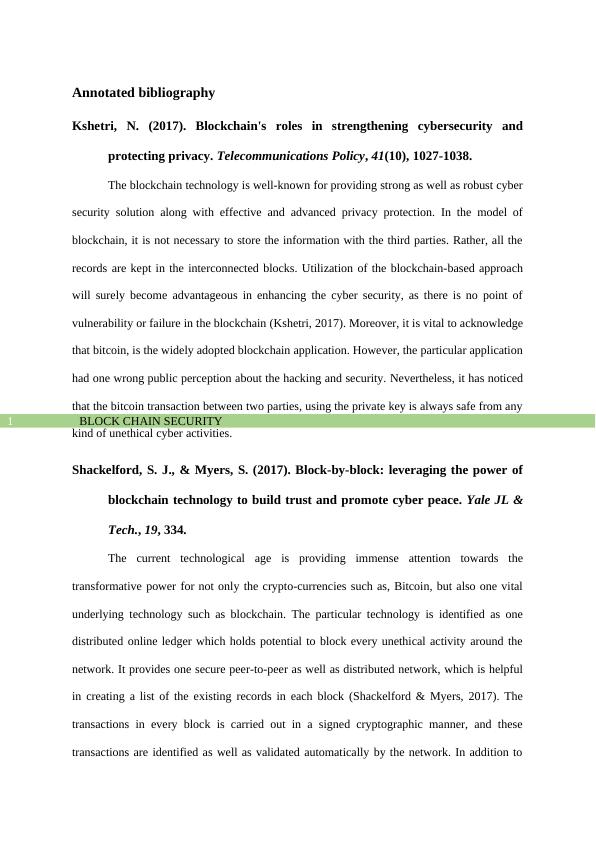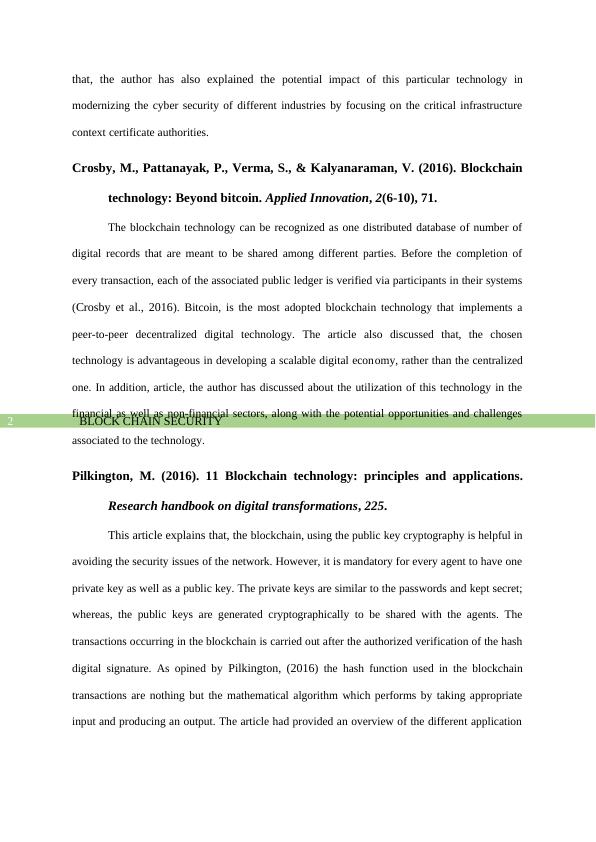Block Chain Security Article 2022
Added on 2022-10-13
11 Pages2780 Words11 Views
Running head: Block chain security
Importance of block chain in cyber security
Name of Student
Name of the University
Author note
Importance of block chain in cyber security
Name of Student
Name of the University
Author note

BLOCK CHAIN SECURITY1
Annotated bibliography
Kshetri, N. (2017). Blockchain's roles in strengthening cybersecurity and
protecting privacy. Telecommunications Policy, 41(10), 1027-1038.
The blockchain technology is well-known for providing strong as well as robust cyber
security solution along with effective and advanced privacy protection. In the model of
blockchain, it is not necessary to store the information with the third parties. Rather, all the
records are kept in the interconnected blocks. Utilization of the blockchain-based approach
will surely become advantageous in enhancing the cyber security, as there is no point of
vulnerability or failure in the blockchain (Kshetri, 2017). Moreover, it is vital to acknowledge
that bitcoin, is the widely adopted blockchain application. However, the particular application
had one wrong public perception about the hacking and security. Nevertheless, it has noticed
that the bitcoin transaction between two parties, using the private key is always safe from any
kind of unethical cyber activities.
Shackelford, S. J., & Myers, S. (2017). Block-by-block: leveraging the power of
blockchain technology to build trust and promote cyber peace. Yale JL &
Tech., 19, 334.
The current technological age is providing immense attention towards the
transformative power for not only the crypto-currencies such as, Bitcoin, but also one vital
underlying technology such as blockchain. The particular technology is identified as one
distributed online ledger which holds potential to block every unethical activity around the
network. It provides one secure peer-to-peer as well as distributed network, which is helpful
in creating a list of the existing records in each block (Shackelford & Myers, 2017). The
transactions in every block is carried out in a signed cryptographic manner, and these
transactions are identified as well as validated automatically by the network. In addition to
Annotated bibliography
Kshetri, N. (2017). Blockchain's roles in strengthening cybersecurity and
protecting privacy. Telecommunications Policy, 41(10), 1027-1038.
The blockchain technology is well-known for providing strong as well as robust cyber
security solution along with effective and advanced privacy protection. In the model of
blockchain, it is not necessary to store the information with the third parties. Rather, all the
records are kept in the interconnected blocks. Utilization of the blockchain-based approach
will surely become advantageous in enhancing the cyber security, as there is no point of
vulnerability or failure in the blockchain (Kshetri, 2017). Moreover, it is vital to acknowledge
that bitcoin, is the widely adopted blockchain application. However, the particular application
had one wrong public perception about the hacking and security. Nevertheless, it has noticed
that the bitcoin transaction between two parties, using the private key is always safe from any
kind of unethical cyber activities.
Shackelford, S. J., & Myers, S. (2017). Block-by-block: leveraging the power of
blockchain technology to build trust and promote cyber peace. Yale JL &
Tech., 19, 334.
The current technological age is providing immense attention towards the
transformative power for not only the crypto-currencies such as, Bitcoin, but also one vital
underlying technology such as blockchain. The particular technology is identified as one
distributed online ledger which holds potential to block every unethical activity around the
network. It provides one secure peer-to-peer as well as distributed network, which is helpful
in creating a list of the existing records in each block (Shackelford & Myers, 2017). The
transactions in every block is carried out in a signed cryptographic manner, and these
transactions are identified as well as validated automatically by the network. In addition to

BLOCK CHAIN SECURITY2
that, the author has also explained the potential impact of this particular technology in
modernizing the cyber security of different industries by focusing on the critical infrastructure
context certificate authorities.
Crosby, M., Pattanayak, P., Verma, S., & Kalyanaraman, V. (2016). Blockchain
technology: Beyond bitcoin. Applied Innovation, 2(6-10), 71.
The blockchain technology can be recognized as one distributed database of number of
digital records that are meant to be shared among different parties. Before the completion of
every transaction, each of the associated public ledger is verified via participants in their systems
(Crosby et al., 2016). Bitcoin, is the most adopted blockchain technology that implements a
peer-to-peer decentralized digital technology. The article also discussed that, the chosen
technology is advantageous in developing a scalable digital economy, rather than the centralized
one. In addition, article, the author has discussed about the utilization of this technology in the
financial as well as non-financial sectors, along with the potential opportunities and challenges
associated to the technology.
Pilkington, M. (2016). 11 Blockchain technology: principles and applications.
Research handbook on digital transformations, 225.
This article explains that, the blockchain, using the public key cryptography is helpful in
avoiding the security issues of the network. However, it is mandatory for every agent to have one
private key as well as a public key. The private keys are similar to the passwords and kept secret;
whereas, the public keys are generated cryptographically to be shared with the agents. The
transactions occurring in the blockchain is carried out after the authorized verification of the hash
digital signature. As opined by Pilkington, (2016) the hash function used in the blockchain
transactions are nothing but the mathematical algorithm which performs by taking appropriate
input and producing an output. The article had provided an overview of the different application
that, the author has also explained the potential impact of this particular technology in
modernizing the cyber security of different industries by focusing on the critical infrastructure
context certificate authorities.
Crosby, M., Pattanayak, P., Verma, S., & Kalyanaraman, V. (2016). Blockchain
technology: Beyond bitcoin. Applied Innovation, 2(6-10), 71.
The blockchain technology can be recognized as one distributed database of number of
digital records that are meant to be shared among different parties. Before the completion of
every transaction, each of the associated public ledger is verified via participants in their systems
(Crosby et al., 2016). Bitcoin, is the most adopted blockchain technology that implements a
peer-to-peer decentralized digital technology. The article also discussed that, the chosen
technology is advantageous in developing a scalable digital economy, rather than the centralized
one. In addition, article, the author has discussed about the utilization of this technology in the
financial as well as non-financial sectors, along with the potential opportunities and challenges
associated to the technology.
Pilkington, M. (2016). 11 Blockchain technology: principles and applications.
Research handbook on digital transformations, 225.
This article explains that, the blockchain, using the public key cryptography is helpful in
avoiding the security issues of the network. However, it is mandatory for every agent to have one
private key as well as a public key. The private keys are similar to the passwords and kept secret;
whereas, the public keys are generated cryptographically to be shared with the agents. The
transactions occurring in the blockchain is carried out after the authorized verification of the hash
digital signature. As opined by Pilkington, (2016) the hash function used in the blockchain
transactions are nothing but the mathematical algorithm which performs by taking appropriate
input and producing an output. The article had provided an overview of the different application

BLOCK CHAIN SECURITY3
of blockchain along with an explanation of the public, private and hybrid blockchain; in addition
to that, the use of appropriate resources makes the article an authentic one.
Puthal, D., Malik, N., Mohanty, S. P., Kougianos, E., & Yang, C. (2018). The
blockchain as a decentralized security framework [future directions].
IEEE Consumer Electronics Magazine, 7(2), 18-21.
Blockchain is one emerging technologies for ensuring the cybersecurity. The
usefulness of this technology has successfully replaced all type of economic transaction in
various organizations. Although it promises a secure distributed framework to facilitate
sharing, exchanging and integration of information across all the users and third parties, it is
important for the planners and decision-makers to analyse it in-depth for its suitability in their
industry and business applications. The advanced cryptography used in this distributed public
keep the data encrypted and safe. Moreover, it discards using the centralized devices in
different networking forms including IoT. Hence it becomes easy for the devices to manage
bugs, update their software and perform direct communication.
MATANOVIĆ, A. (2017). Blockchain/Cryptocurrencies and Cybersecurity,
Threats and Opportunities. For Publisher, 11.
This article highlighted the block chain as one underlying technology used by the
Cryptocurrencies. According to MATANOVIĆ, (2017) blockchains are distributed database
that creates several blocks for maintaining the set of information. Moreover, the blockchains
used in the cryptocurrency reflects the public ledger associated to every transaction.
However, the Public blockchains are most likely to affect by the lesser available of
bandwidth and minimal storage capacity. Furthermore, these are also accessible by anyone
who makes unfeasible storage of the sensitive data. Whereas, the private blockchains, as
compared to the public ones are flexible and have more storage capacity.
of blockchain along with an explanation of the public, private and hybrid blockchain; in addition
to that, the use of appropriate resources makes the article an authentic one.
Puthal, D., Malik, N., Mohanty, S. P., Kougianos, E., & Yang, C. (2018). The
blockchain as a decentralized security framework [future directions].
IEEE Consumer Electronics Magazine, 7(2), 18-21.
Blockchain is one emerging technologies for ensuring the cybersecurity. The
usefulness of this technology has successfully replaced all type of economic transaction in
various organizations. Although it promises a secure distributed framework to facilitate
sharing, exchanging and integration of information across all the users and third parties, it is
important for the planners and decision-makers to analyse it in-depth for its suitability in their
industry and business applications. The advanced cryptography used in this distributed public
keep the data encrypted and safe. Moreover, it discards using the centralized devices in
different networking forms including IoT. Hence it becomes easy for the devices to manage
bugs, update their software and perform direct communication.
MATANOVIĆ, A. (2017). Blockchain/Cryptocurrencies and Cybersecurity,
Threats and Opportunities. For Publisher, 11.
This article highlighted the block chain as one underlying technology used by the
Cryptocurrencies. According to MATANOVIĆ, (2017) blockchains are distributed database
that creates several blocks for maintaining the set of information. Moreover, the blockchains
used in the cryptocurrency reflects the public ledger associated to every transaction.
However, the Public blockchains are most likely to affect by the lesser available of
bandwidth and minimal storage capacity. Furthermore, these are also accessible by anyone
who makes unfeasible storage of the sensitive data. Whereas, the private blockchains, as
compared to the public ones are flexible and have more storage capacity.

End of preview
Want to access all the pages? Upload your documents or become a member.
Related Documents
International Conference on Contemporary Computinglg...
|13
|2851
|23
(PDF) Blockchain Technology: Financial Sector Applicationslg...
|7
|1102
|114
Blockchain Technology: Industry Uses, Background, Purpose, and Valuelg...
|8
|1837
|306
Blockchain: A Distributed Ledger for Transactional Datalg...
|12
|3000
|133
Blockchain Technology: Applications, Working Mechanism, and Futurelg...
|10
|3242
|97
Networking Application Managementlg...
|10
|2627
|306
